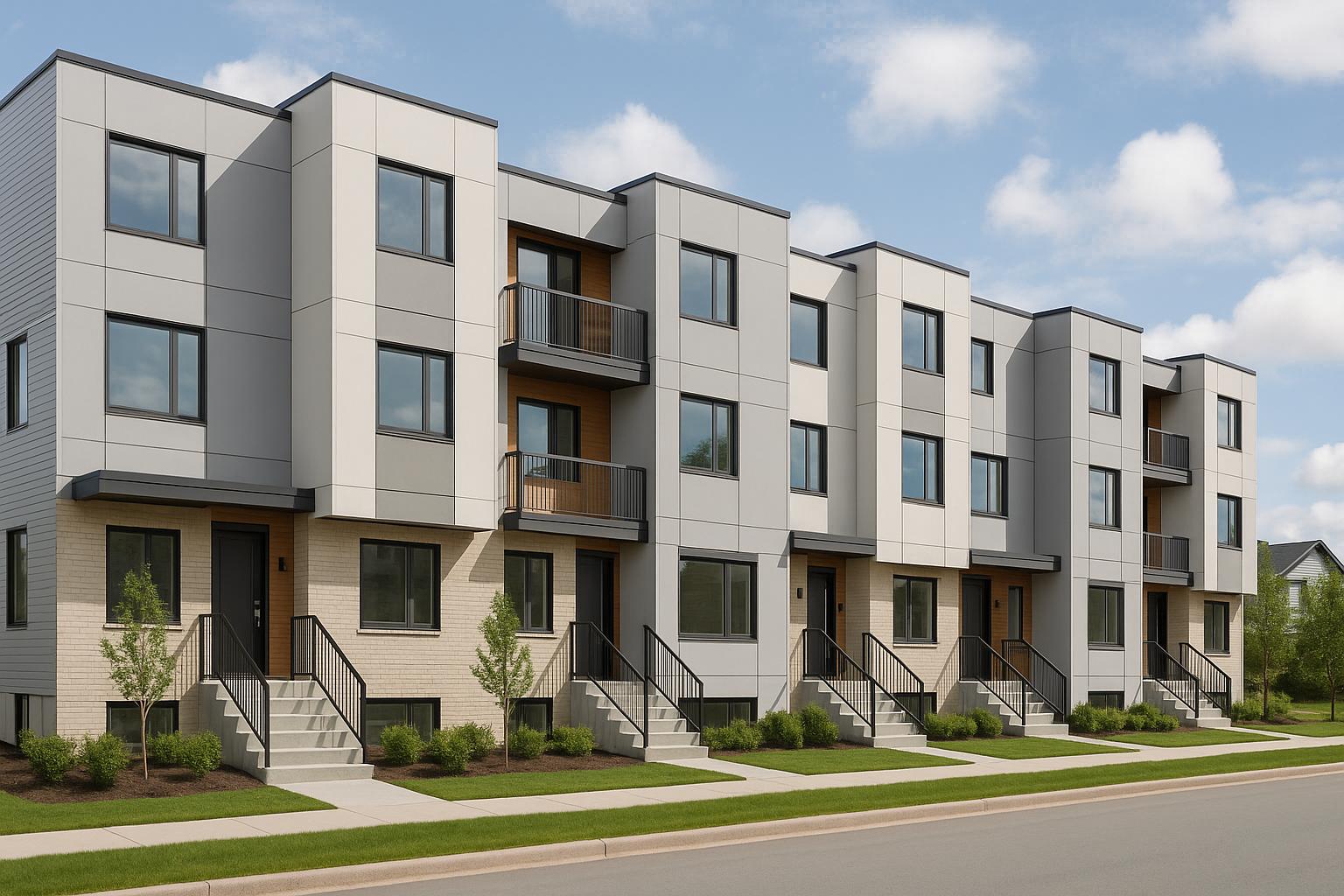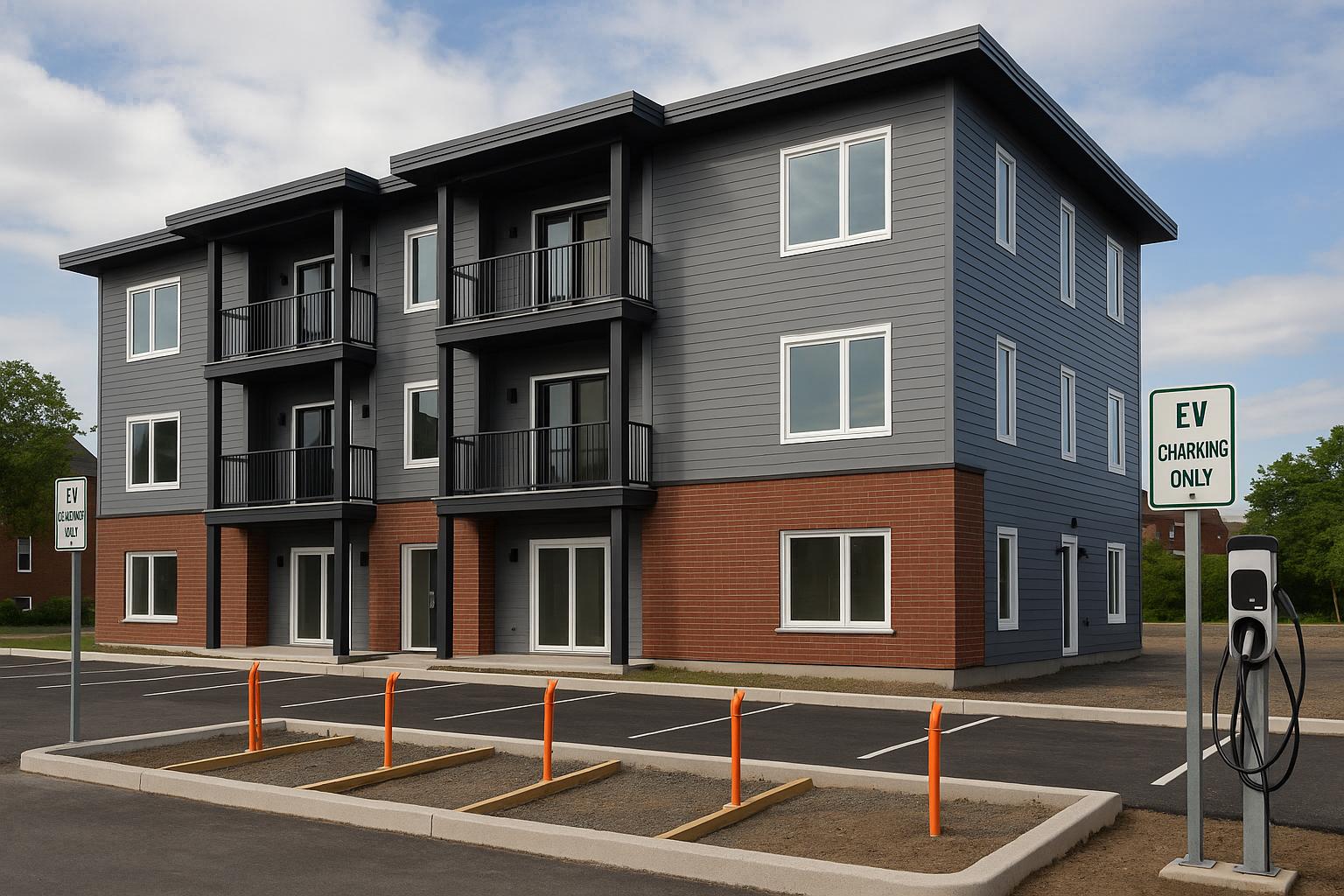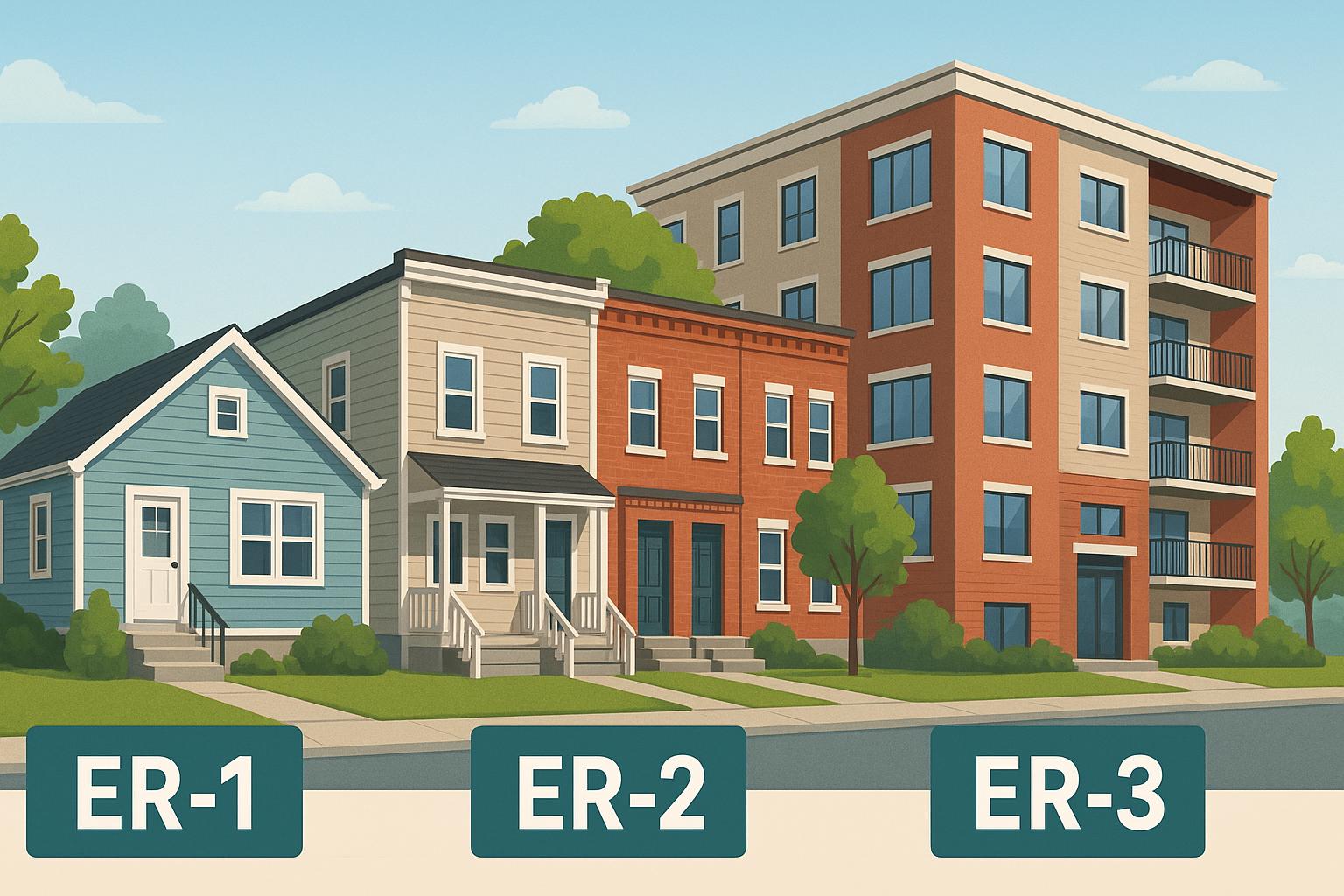Want to develop small shared housing in Halifax's ER-2 zones? Here's what you need to know:
ER-2 zoning allows for higher-density housing like duplexes, triplexes, and fourplexes, but there are strict rules to follow:
- Bedroom Limits: Capped at 6–8 per unit, depending on property type and lot size.
- Occupancy Rules: Bedrooms must meet egress, safety, and size standards under local laws and the National Building Code.
- Layout Requirements: Shared spaces (kitchens, bathrooms) must accommodate total occupancy and meet accessibility standards.
- Parking and Outdoor Space: Must align with zoning regulations to avoid penalties.
- Construction Approach: Integrated design-build methods can save time and money compared to fragmented construction processes.
Following these rules ensures compliance, avoids costly retrofits, and maximizes rental income. Projects typically yield 12–20% annual ROI, with monthly rents averaging $3,900–$4,200. Compliance also opens doors to financing options like CMHC MLI Select.
For a smooth process, consult professionals early, use approved layouts, and stay within ER-2 limits. Proper planning leads to safer, more liveable properties and stronger financial returns.
How to Quickly Look Up Zoning in Halifax, Nova Scotia
Bedroom Caps and Occupancy Limits in ER-2
Navigating bedroom limits and occupancy rules is essential for maximizing rental income while staying within Halifax's ER-2 zoning regulations. These rules determine how many tenants a property can accommodate, directly impacting its rental potential.
Maximum Bedroom Limits
Under ER-2 zoning, the maximum number of bedrooms allowed depends on the property type - whether it's a duplex, triplex, or fourplex - and the lot size. Smaller lots often face stricter restrictions, so it's crucial to consult the latest zoning guidelines to confirm the limits specific to your property.
Interestingly, ER-2 zoning defines a "bedroom" more broadly than just rooms officially designated as such. Any space that meets local criteria and could reasonably function as a sleeping area may count as a bedroom. This makes it important to carefully plan layouts to comply with regulations while maximizing rental yields.
Occupancy and Safety Standards
Occupancy rules must adhere to both local zoning laws and the National Building Code. These regulations outline minimum room sizes and require clear egress routes for safety. For example, basement bedrooms must meet specific fire exit requirements and minimum floor area standards.
Shared spaces like kitchens and bathrooms must be appropriately sized to handle the total number of occupants, ensuring safe and comfortable living conditions. Tenant satisfaction often hinges on these shared amenities being adequate for the resident load.
Parking requirements also play a role in occupancy limits. Zoning laws may mandate a certain number of parking spaces based on the number of residents. In shared housing developments, higher occupancy can increase parking demand, which may restrict the number of tenants allowed, even if zoning permits more bedrooms.
These safety and logistical considerations highlight the importance of adhering to bedroom caps.
Why Bedroom Caps Exist
Bedroom caps exist to address a variety of practical concerns. They help manage population density, which prevents local services and municipal infrastructure - such as water, sewer, and transportation systems - from becoming overburdened. By limiting the number of bedrooms, these rules ensure that neighbourhoods remain functional and liveable.
More importantly, bedroom caps are designed to protect tenant welfare. They ensure that shared housing developments provide adequate personal space and access to common facilities. This balance promotes not only the comfort and safety of residents but also the overall quality and harmony of the surrounding community.
Layout Requirements for Small Shared Housing
Creating effective layouts for ER-2 small shared housing involves balancing compliance with building codes and zoning regulations while meeting tenant needs and optimizing rental income. The design must ensure safety, comfort, and functionality for residents.
Required Layout Elements
ER-2 layouts must include essential features that meet both safety standards and livability expectations. Bedrooms should provide sufficient space, natural light, and ventilation, with direct access to shared areas to promote convenience.
Shared kitchens should be equipped with ample counter space, storage, and appliances to accommodate all residents. These facilities must meet occupancy-based requirements outlined by local building codes and include proper ventilation and fire safety measures.
Bathrooms should align with the number of bedrooms and total occupancy. While several bedrooms may share full bathrooms, adding half-bathrooms can improve convenience, as long as they complement and do not replace the required full facilities.
Accessibility is critical for new builds and renovations. Ground-floor units should be wheelchair-friendly, with wider doorways and accessible fixtures. Multi-storey buildings may require elevator access or dedicated accessible units to meet these standards.
Fire safety must also be a top priority. This includes clear exit routes from all rooms, properly placed smoke detectors in private and shared spaces, and fire-resistant separations between units. Special attention should be given to basement bedrooms, which need emergency exits that meet compliance standards.
These elements form the foundation for practical and efficient housing layouts.
Sample Approved Layouts
Approved layouts often illustrate how to maximize bedroom numbers without compromising shared spaces. The key is balancing modestly sized bedrooms with well-designed common areas to ensure both comfort and efficiency.
Duplex layouts are a popular choice for shared housing. Each side of the duplex can feature a balanced number of bedrooms sharing kitchen and bathroom facilities, naturally separating resident groups and improving cost efficiency.
For larger buildings, triplex and fourplex configurations work well. These designs can either include shared spaces within individual units or spread shared areas across the building. Many tenants prefer layouts where shared spaces are confined to individual units, as this often improves satisfaction and simplifies lease management.
To enhance functionality, high-traffic areas like kitchens and bathrooms are typically placed centrally to minimize noise in bedrooms. Bedrooms are often positioned along exterior walls to maximize natural light and airflow. Incorporating storage solutions - both communal and individual - adds to tenant comfort and helps maintain order.
Shared Space Design Requirements
Building on approved layouts, shared spaces should prioritize both practicality and comfort. Kitchens should be designed to accommodate multiple users, with defined zones for appliances, workspaces, and seating. Depending on the available space, open-plan islands or compact galley kitchens may be suitable options.
Living areas, while not bound by strict size requirements, should be large enough to encourage communal use and connect seamlessly with the kitchen. These spaces should remain distinct from quieter bedroom zones to reduce disturbances.
Storage is another critical aspect. Organized pantry spaces, structured refrigerator sections, personal storage options, and entryway storage for items like coats and cleaning supplies can help streamline daily living and minimize conflicts.
Laundry facilities, whether in-unit or shared, add significant value. These should be integrated thoughtfully with proper utility connections and ventilation to ensure convenience and efficiency.
Outdoor areas, such as balconies, patios, or shared yards, enhance the overall appeal of the property. Ground-floor units might include private outdoor spaces, while upper-level units can benefit from balconies or shared rooftop areas.
An integrated design-build approach ensures that all elements - from planning to construction - align smoothly, minimizing compliance issues and ensuring a more efficient project delivery process.
sbb-itb-16b8a48
ER-2 Compliance: Common Problems and Solutions
Building ER-2 small shared housing that meets compliance standards requires careful planning. Overlooking key requirements or relying on disjointed construction methods can lead to delays and increased costs.
Common Compliance Mistakes
One frequent issue is exceeding bedroom caps. While adding more bedrooms might seem like a good way to boost rental income, failing to consider lot size, parking requirements, and local bylaws can result in costly redesigns and project delays.
Another common problem is inadequate fire safety measures, especially in basement bedrooms. Without proper emergency exits, egress windows, or fire-resistant separations between units, properties may face expensive retrofits to meet safety standards.
Misjudging shared space needs is another pitfall. Building codes often base kitchen and bathroom requirements on total occupancy, not just the number of bedrooms. Failing to provide enough shared facilities can lead to permit issues and unhappy tenants.
Parking and outdoor space shortfalls can also cause compliance headaches. ER-2 zones typically have specific parking ratios and outdoor amenity space requirements. Falling short in these areas can result in enforcement actions that disrupt rental operations.
Lastly, accessibility oversights can lead to significant retrofitting costs. New construction must meet accessibility standards, including proper door widths, bathroom layouts, and entrance designs.
How to Ensure Compliance
To avoid these pitfalls, several proactive steps can make a big difference:
- Consult with municipal planners early. Pre-application meetings with planning staff can help identify potential compliance issues before they escalate into costly problems.
- Bring in experienced professionals. Architects familiar with ER-2 regulations can spot potential issues during the design phase, ensuring your plans align with local codes.
- Use proven floor plan templates. Adapting layouts that have already been approved by municipalities can save time and reduce risk compared to starting from scratch.
- Coordinate permits effectively. Aligning building, development, and occupancy permits ensures a smoother process with fewer delays.
- Schedule regular inspections. Routine checks help verify compliance and catch problems early.
These steps set the stage for a comparison between integrated design-build methods and traditional construction approaches.
Integrated Design-Build vs Traditional Construction
When it comes to addressing compliance issues, the choice between integrated design-build and traditional construction methods can significantly impact timelines, costs, and outcomes.
Traditional construction often involves juggling multiple professionals - architects, engineers, contractors, and subcontractors - each with their own schedules and priorities. This fragmented approach can lead to confusion and delays when compliance issues arise, as responsibility is spread across several parties.
On the other hand, integrated design-build firms, like Helio Urban Development, streamline the process by bringing all professionals under one roof. Helio's co-founder Lloyd Liu emphasizes the benefits of this approach:
"I personally guarantee every timeline because I've felt the pain of construction delays."
With a single point of accountability, integrated design-build methods resolve compliance matters faster and eliminate disputes over responsibility.
| Construction Approach | Traditional Fragmented | Integrated Design-Build |
|---|---|---|
| Accountability | Multiple contracts requiring coordination | Single company responsibility |
| Pricing Structure | Cost-plus pricing with potential overruns (30–60%) | Fixed price at $160,000 per unit |
| Timeline Delivery | Typically 12–18 months | 6 months guaranteed |
| Compliance Coordination | Owner manages approvals across parties | One team handles all approvals |
| Quality Control | Varies by contractor | Triple verification system |
| Delay Penalties | Owner bears delay costs | Penalties up to $1,000 per day |
The financial implications are clear. Traditional methods often result in extended timelines, delaying rental income. Meanwhile, integrated design-build approaches ensure properties are ready to generate revenue on schedule. Helio Urban Development’s approach has consistently helped property owners avoid budget overruns and achieve smoother project outcomes.
Yuan He, Helio’s co-founder and data scientist, highlights the role of technology in their process:
"Our scheduling system prevents the delays that killed our first construction project."
Maximizing Rental Income While Meeting ER-2 Rules
ER-2 shared housing projects strike a balance between meeting regulatory requirements and delivering solid financial returns. Property owners who carefully plan their layouts and stay within the rules can see strong rental income while building long-term wealth.
Layout Design for Maximum ROI
Creating a smart layout is all about maximizing the number of bedrooms allowed under ER-2 zoning while ensuring shared spaces remain functional and appealing. In these zones, shared housing typically includes 4 to 10 bedrooms, depending on the lot size and building constraints. Efficient use of space is crucial - adding rear extensions or converting internal areas often aligns well with ER-2 guidelines.
Shared spaces, like kitchens and living areas, play a big role in tenant satisfaction. A well-thought-out design can reduce vacancy rates by keeping tenants happy. Designers often find ways to reconfigure hallways or bathrooms to add extra bedrooms without sacrificing the overall comfort of the home.
Finding the sweet spot between the number of bedrooms and the quality of shared areas is essential. While more bedrooms can increase rental income, overcrowded common areas might lead to higher tenant turnover, ultimately affecting profitability. A balanced layout directly impacts the income potential, as explained below.
Rental Income and ROI Numbers
Monthly rental income for ER-2 shared housing typically falls between $3,900 and $4,200. The average fixed cost per unit is approximately $160,000. This pricing model allows property owners to predict returns with greater accuracy, avoiding the budget overruns that often occur with traditional construction methods, which can add 30–60% to costs.
Annual ROI for compliant ER-2 properties ranges from 12% to 20%. Projects that qualify for CMHC MLI Select financing enjoy additional benefits, such as up to 95% financing and 50-year amortization periods, which can significantly improve cash flow.
Traditional construction methods can delay rental income by 6 to 10 months compared to integrated approaches, potentially costing as much as $40,000 in lost revenue at $4,000 per month. By using streamlined construction techniques, property owners can start generating income sooner and protect their overall returns.
Long-Term Benefits of Compliance
Compliance with ER-2 regulations delivers more than just immediate financial rewards - it also supports long-term property performance. Properties that meet these standards often see increased value, thanks to avoiding legal risks and costly retrofits that non-compliant properties might face. Additionally, compliance makes it easier to qualify for financing programs like CMHC MLI Select, which offers favourable terms for energy-efficient and affordable rental projects.
Compliant properties also tend to experience lower vacancy rates. Well-maintained and legally approved housing is more likely to attract stable, long-term tenants. Moreover, staying within the rules reduces the risk of enforcement actions and unexpected expenses for corrections. These factors, combined with stronger financing options, can lead to better refinancing terms and higher property valuations when it's time to sell or expand a portfolio.
Conclusion: Building Compliant Rental Properties in ER-2
Creating successful shared housing in ER-2 zones starts with a firm commitment to following the rules. With bedroom caps set at 6 to 8 per unit[1][2], property owners can use these clear limits as a guide to design spaces that meet both zoning and building codes. This approach doesn’t just ensure compliance - it lays the groundwork for long-term success and the financial advantages that come with it.
Staying compliant offers more than just peace of mind. It secures steady rental income, boosts annual returns, and helps property owners avoid expensive retrofits. Plus, compliance opens doors to benefits like CMHC MLI Select financing and attracts tenants who value safe, well-maintained housing.
One of the smartest ways to achieve this is through integrated design-build methods. By embedding compliance into every phase - from initial planning to construction - you can sidestep common pitfalls like coordination issues or budget overruns, which can range from 30% to 60%. This streamlined approach ensures that every decision supports the overall vision while keeping the project on track.
Working with professionals who understand ER-2 compliance is key. When design, engineering, and construction experts collaborate as a unified team, compliance becomes a seamless part of the process rather than a stumbling block. This not only simplifies the project but also strengthens its financial and operational performance.
Starting with compliance from day one saves property owners from the stress and expense of fixing mistakes later. Opting for fixed-price construction models with guaranteed timelines further protects budgets and ensures cash flow remains steady. This structured approach makes building compliant shared housing both manageable and profitable.
Ultimately, success in ER-2 shared housing isn't about bending the rules - it's about working within them. By combining smart design with experienced construction teams, property owners can create spaces that not only meet regulations but also thrive financially.
FAQs
How do bedroom caps in ER-2 zoning affect rental income opportunities for property owners?
In areas designated as ER-2 zoning, properties are restricted to a maximum of 10 bedrooms. This limit directly affects rental income by setting a cap on the number of tenants or units a property can accommodate, potentially reducing its earning potential.
To optimize your investment under these restrictions, prioritizing smart layouts and practical shared spaces is key. By designing spaces that appeal to tenants while adhering to zoning rules, you can strike a balance between compliance and maximizing rental returns. Thoughtful planning can make all the difference in achieving a strong rental yield.
What are the key advantages of using a design-build approach for small shared housing projects in ER-2 zones?
The design-build method brings several practical advantages for small shared housing projects in ER-2 zones across Nova Scotia. By placing both design and construction under one team, this approach ensures smooth communication, quicker decision-making, and a more streamlined workflow from start to finish. It helps cut down delays, prevents miscommunication between separate teams, and keeps projects on schedule and within budget.
One standout benefit is the ability to identify and address potential challenges early in the planning stage. This reduces unexpected expenses and ensures zoning regulations are met. The collaborative nature of design-build also allows property owners to create efficient layouts that maximize rental income while meeting ER-2 standards, ultimately saving both time and money.
How do ER-2 zoning rules and the National Building Code impact property value and tenant satisfaction?
Adhering to ER-2 zoning regulations and the National Building Code plays a key role in safeguarding the long-term value of your property. These standards are in place to ensure that developments meet essential safety, quality, and density guidelines - factors that resonate with both tenants and investors.
By following these regulations, you’re also prioritizing tenant satisfaction. Safe, functional, and well-thought-out living spaces tend to attract long-term tenants, which translates into higher occupancy rates, reduced tenant turnover, and lower maintenance expenses over time. Beyond avoiding costly compliance issues, sticking to these standards can make your property a standout choice in the rental market, appealing as both a secure and attractive investment.



